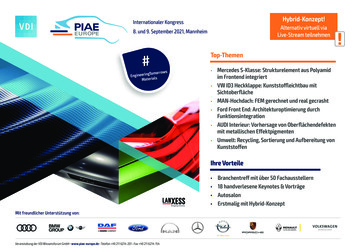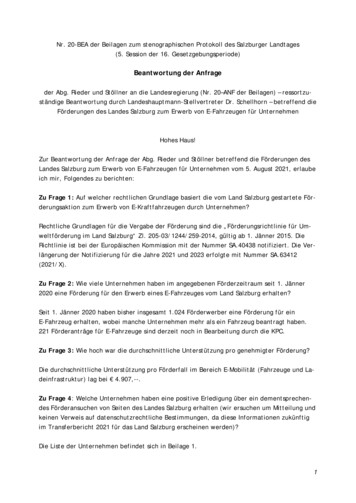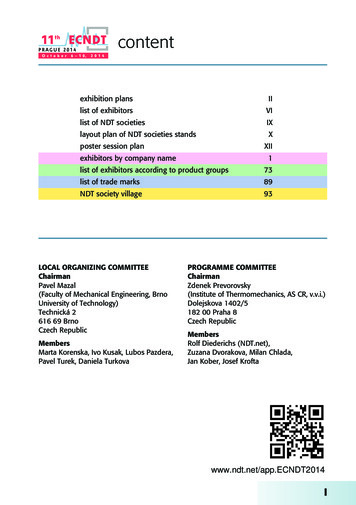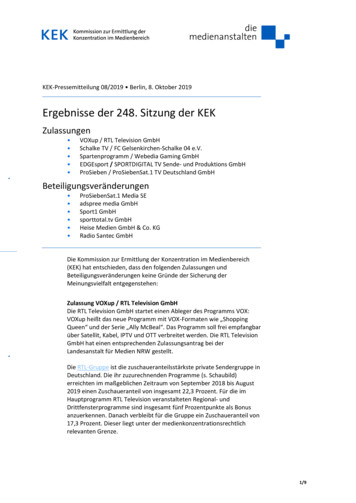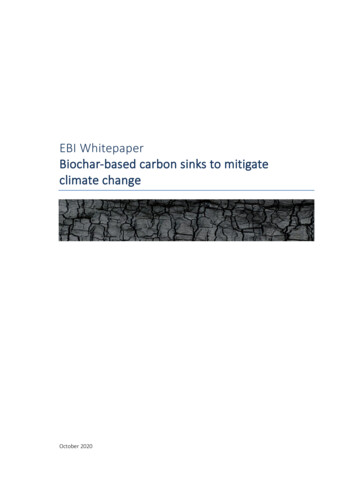
Transcription
European Coatings Tech FilesThe Mission: Extremely practical coverage of the mathematical andphysical principles behind rheology – from flow properties toviscoelastic behavior to taking actual measurements and inter preting them correctly. To provide a sound basis for learning aboutthe principles of rheology and successfully applying them.Thomas G. MezgerThe Rheology Handbook3rd Revised EditionThe Value: This book describes the principles of rheology clearly,vividly and in practical terms. The third edition of this standardwork has been expanded to include the rheology of additives inwater-based dispersions and surfactant systems. Not only is it agreat reference book, it can also serve as a textbook for studyingthe theory behind the methods.ISBN 978-3-86630-890-9Thomas G. Mezger · The Rheology Handbook 3rd Revised EditionThe Audience: Beginners with no previous knowledge of rheology,as well as advanced users seeking to refresh their knowledge andfind out about the latest developments. For all those who seek adeeper understanding of rheology or who simply want a referencebook for their daily work.eBook
Vincentz Network GmbH & Co KG
Thomas G. MezgerTheRheology HandbookFor users ofrotational and oscillatory rheometers3rd revised editionThomas G. Mezger: The Rheology Handbook Copyright 2011 by Vincentz Network, Hanover, GermanyISBN 978-3-86630-890-9Mezger Rheology Handbook.indb 117.01.2011 08:11:05
Cover: Wacker Chemie, Burghausen, GermanyBibliographische Information der Deutschen BibliothekDie Deutsche Bibliothek verzeichnet diese Publikation in der DeutschenNationalbibliographie; detaillierte bibliographische Daten sind im Internetüber http://dnb.ddb.de abrufbar.Mezger, Thomas G.The Rheology Handbook, 3rd revised editionHanover: Vincentz Network, 2011European Coatings Tech FilesISBN 3-86630-890-6ISBN 978-3-86630-890-9 2011 Vincentz Network GmbH & Co. KG, HanoverVincentz Network GmbH & Co. KG, Plathnerstr. 4c, 30175 Hanover, GermanyThis work is copyrighted, including the individual contributions and figures.Any usage outside the strict limits of copyright law without the consent of the publisher is prohibited andpunishable by law. This especially pertains to reproduction, translation, microfilming and the storage andprocessing in electronic systems.The information on formulations is based on testing performed to the best of our knowledge.Please ask for our book catalogueVincentz Network, Plathnerstr. 4c, 30175 Hanover, GermanyT 49 511 9910-033, F 49 511 9910-029books@european-coatings.com, www.european-coatings.comLayout: Vincentz Network, Hanover, GermanyPrinted by: Quensen Druck Verlag GmbH & Co. KG, Hildesheim, GermanyISBN 3-86630-890-6ISBN 978-3-86630-890-9Mezger Rheology Handbook.indb 217.01.2011 08:11:05
European Coatings Tech FilesThomas G. MezgerTheRheology HandbookFor users ofrotational and oscillatory rheometers3rd revised editionMezger Rheology Handbook.indb 317.01.2011 08:11:05
Mezger Rheology Handbook.indb 417.01.2011 08:11:05
ForewordWhy was this book written?People working in industry are often confronted with the effects of rheology, the science ofdeformation and flow behavior. When looking for appropriate literature, they find either shortbrochures which give only a few details and contain little useful information, or highly specialized books overcharged of physical formulas and mathematical theories. There is a lack ofliterature between these two extremes which reduces the discussion of theoretical principlesto the necessary topics, providing useful instructions for experiments on material characterization. This book is intended to fill that gap.The practical use of rheology is presented in the following areas: quality control (QC), productionand application, chemical and mechanical engineering, industrial research and development,and materials science. Emphasis is placed on current test methods related to daily working practice. After reading this book, the reader should be able to perform useful tests with rotationaland oscillatory rheometers, and to interpret the achieved results correctly.How did this book come into existence?The first computer-controlled rheometers came into use in industrial laboratories in the mid 1980s.Ever since then, test methods as well as control and analysis options have improved with breathtaking speed. In order to organize and clarify the growing mountain of information, company AntonPaar Germany – and previously Physica Messtechnik – has offered basic seminars on rheologyalready since 1988, focused on branch-specific industrial application. During the “European Coatings Show” in Nuremberg in April 1999, the organizer and publishing director Dr. Lothar Vincentzsuggested expanding these seminar notes into a comprehensive book about applied rheology.What is the target audience for this book? For which industrialbranches will it be most interesting?“The Rheology Handbook” is written for everyone approaching rheology without any priorknowledge, but is also useful to people wishing to update their expertise with information aboutrecent developments. The reader can use the book as a course book and read from beginning toend or as a reference book for selected chapters. The numerous cross-references make connections clear and the detailed index helps when searching. If required, the book can be used asthe first step on the ladder towards theory-orientated rheology books at university level. In orderto break up the text, there are as well many figures and tables, illustrative examples and smallpractical experiments, as well as several exercises for calculations. The following list reflectshow the contents of the book are of interest to rheology users in many industrial branches. Polymers: Solutions, melts, solids; film emulsions, cellulose solutions, latex emulsions, solid films,sheetings, laminates; natural resins, epoxies, casting resins; silicones, caoutchouc, gums, soft andhard rubbers; thermoplastics, elastomers, thermosets, blends, foamed materials; unlinked andcross-linked polymers containing or without fillers or fibers; polymeric compounds and composites; solid bars of glass-fibre, carbon-fibre and synthetic-fibre reinforced polymers (GFRP, CFRP,SFRP); polymerization, cross-linking, curing, vulcanization, melting and hardening processesThomas G. Mezger: The Rheology Handbook Copyright 2011 by Vincentz Network, Hanover, GermanyISBN 978-3-86630-890-9Mezger Rheology Handbook.indb 517.01.2011 08:11:05
6Foreword Adhesives and sealants: Glues, single and multi-component adhesives, pressure sensitiveadhesives (PSA), UV curing adhesives, hotmelts, plastisol pastes (e.g. for automotive underseals and seam sealings), construction adhesives, putties; uncured and cured adhesives;curing process; tack, stringiness Coatings, paints, lacquers: Spray, brush, dip coatings; solvent-borne, water-based coatings;metallic effect, textured, low solids, high solids, photo-resists, UV (ultra violet) radiationcuring, powder coatings; glazes and stains for wood; coil coatings; solid coating films Printing inks and varnishes: Gravure, letterpress, flexographic, planographic, offset,screen printing inks, UV (ultra violet) radiation curing inks; ink-jet printer inks; writing inksfor pens; millbase premix, color pastes, “thixo-pastes”; liquid and pasty pigment dispersions;printing process; misting; tack Paper coatings: Primers and topcoats; immobilization process Foodstuffs: Water, vegetable oils, aroma solvents, fruit juices, baby food, liquid nutrition, liqueurs,syrups, purees, thickeners an stabilizing agents, gels, pudding, jellies, ketchup, mayonnaise,mustard, dairy products (such as yogurt, cream cheese, cheese spread, soft and hard cheese,curds, butter), emulsions, chocolate (melt), soft sweets, ice cream, chewing gum, dough, whiskedegg, cappuccino foam, sausage meat, sauces containing meat chunks, jam containing fruit pieces,animal feed; bio-technological fluids; gel formation of hydrocolloids (e.g. of corn starch and gelatin);interfacial rheology (e.g. for emulsions); food tribology (e.g. for creaminess); tack Cosmetics, pharmaceuticals, medicaments, bio-tech products, personal care, healthand beauty care products: Cough mixtures, perfume oils, wetting agents, nose sprays,X-ray film developing baths, blood (hemo-rheology), blood-plasma substitutes, emulsions (e.g.skin care, hair-dye), lotions, nail polish, roll-on fluids (deodorants), saliva, mucus, hydrogels,shampoo, shower gels, dispersions containing viscoelastic surfactants, skin creams, peelingcreams, hair gels, styling waxes, shaving creams, tooth-gels, toothpastes, makeup dispersions, lipsticks, mascara, ointments, vaseline, biological cells, tissue engineered medicalproducts (TEMPs), natural and synthetic membranes, silicone pads and cushions, dental molding materials, tooth filling, sponges, contact lenses, medical adhesives (for skin plasters ordiapers), denture fixative creams, hair, bone cement, implants, organic-inorganic compounds(hybrids); interfacial rheology (e.g. for emulsions) Agrochemicals: Plant or crop protection agents, solutions and dispersions of insecticides andpesticides, herbicides and fungicides Detergents, home care products: Household cleaning agents, liquid soap, disinfectants,surfactant solutions, washing-up liquids, dish washing agents, laundry, fabric conditioners,washing powder concentrate, fat removers; interfacial rheology Surface technology: Polishing and abrasive suspensions; cooling emulsions Electrical engineering, electronics industry: Thick film pastes, conductive, resistance,insulating, glass paste, soft solder and screen printing pastes; SMD adhesives (for surfacemounted devices), insulating and protective coatings, de-greasing agents, battery fluids andpastes, coatings for electrodes Petrochemicals: Crude oils, petroleum, solvents, fuels, mineral oils, light and heavy oils,lubricating greases, paraffines, waxes, petrolatum, vaseline, natural and polymer-modifiedbitumen, asphalt binders, distillation residues, and from coal and wood: tar and pitch; interfacial rheology (e.g. for emulsions) Ceramics and glass: Casting slips, kaolin and porcelain suspensions, glass powder andenamel pastes, glazes, plastically deformable ceramic pastes, glass melts, aero-gels, xero-gels,sol/gel materials, composites, organo-silanes (hybrids), basalt melts Construction materials: Self-leveling cast floors, plasters, mortar, cement suspensions, tileadhesives, dispersion paints, sealants, floor sheeting, natural and polymer-modified bitumen,asphalt binders for pavements Metals: Melts of magnesium, aluminum, steel, alloys; moulding process in a semi-solid state(“thixo-forming”, “thixo-casting”, “thixo-forging”), ceramic fibre reinforced light-weight metalsMezger Rheology Handbook.indb 617.01.2011 08:11:05
Foreword7 Waste industry: Waste water, sewage sludges, animal excrements (e.g. of fishes, poultry,cats, dogs, pigs), residues from refuse incineration plants Geology, soil mechanics, mining industry: Soil sludges, muds; river and lake sedimentmasses; soil deformation due to mining operations, earthwork, canal and drain constructions;drilling fluids (e.g. containing “flow improvers”) Disaster control: Behavior of burning materials, soil deformation due to floods and earthquakes Materials for special functions (e.g. as “smart fluids”): Magneto-rheological fluids (MRF),electro-rheological fluids (ERF), di-electric (DE) materials, self-repairing coatings, materialsshowing self-organizing superstructures (e.g. surfactants), dilatant fabrics (shock-absorbing,“shot-proof”), liquid crystals (LC), ionic fluids, micro-capsule paraffin wax (e.g. as “phasechange material” PCM)It is pleasing that the first two editions of “The Rheology Handbook”, published in 2002 and2006, sold out so unexpectedly quickly. It was positive to hear that the book met with approval,not only from laboratory technicians and practically oriented engineers, but also from teachersand professors of schools and colleges of applied sciences. Even at universities, “The RheologyHandbook” is meanwhile taken as an introductory teaching material for explaining the basicsof rheology in lectures and practical courses, and as a consequence, many students worldwideare using it when writing their final paper or thesis.Also for the third edition, further present-day examples have been added resulting as well fromcontacts to industrial users as well as from corporation with several working groups, e.g. fordeveloping modern standardizing measuring methods for diverse industrial branches. Here ina nutshell, the following additional chapters of this new edition are: Types of flow in the TwoPlates-Model (Chapter 2.4), the effects of rheological additives in aqueous dispersions (Chapter3.3.7), SAOS and LAOS tests and Lissajous diagrams (Chapter 8.3.6), nano-structures and complex rheological behavior such as shear-banding explained by using surfactant systems as anexample (Chapter 9), and special measuring devices for rheo-optical systems and extensionaltests (Chapter 10.8). Also the references and standards have been updated (Chapter 14). Thistextbook is also available in German language, and also here, three editions were published upto now, in 2000, 2006 and in July of 2010 (title: “Das Rheologie Handbuch”).I hope that “The Rheology Handbook” will prove itself a useful source of information for characterizing the above mentioned products in an application-oriented way, assuring their qualityand helping to improve them wherever possible.AcknowledgementsI would like to say a big “Thank You” to all those people without whose competent ideas andsuggestions for improvement it would not have been possible to produce such a comprehensive and understandable book. The following people have been of special help to me: HeikeAudehm, Monika Bernzen, Stefan Büchner, Marcel de Pender, Gerd Dornhöfer, Andreas Eich,Elke Fischle, Ingrid Funk, Patrick Heyer, Siegfried Huck, Jörg Läuger, Thomas Litters, SabineNeuber, Matthias Prenzel, Hubert Reitberger, Michael Ringhofer, Oliver Sack, Michael Schäffler,Carmen Schönhaar, Werner Stehr, Heiko Stettin, Jürgen Utz, Detlef van Peij, Simone Will andKlaus Wollny. Sarah Knights translated the original German text into English. Besides the support of my colleagues worldwide, I would also like to mention the managers of Anton Paar GmbHin Graz, Austria, and Anton Paar Germany GmbH in Ostfildern (near Stuttgart).Stuttgart, December 2010Thomas G. MezgerMezger Rheology Handbook.indb 717.01.2011 08:11:06
Technology in motion.The Modular CompactRheometer Series offersyou one thing first andforemost: An open rangeof possibilities.Ask your local Anton Paarrepresentative for a quotationor contact us directly:Tel: 43 (0)316 257-0E-mail: info@anton-paar.comFind more information about theMCR series and its new features atwww.anton-paar.com165x260en.indd 1Handbook.indb 8Mezger Rheology19.11.1013:3117.01.201108:11:06
Contents9Contents11.11.2Introduction. 17Rheology, rheometry and viscoelasticity. 17Deformation and flow behavior. 1822.12.22.2.12.2.22.2.32.32.3.12.4Flow behavior and viscosity. 21Introduction. 21Definition of terms. 21Shear stress. 22Shear rate. 22Viscosity. 26Shear load-dependent flow behavior . 29Ideally viscous flow behavior according to Newton. 29Types of flow illustrated by the Two-Plates Model.313Rotational tests. 333.1Introduction. 333.2Basic principles. 333.2.1 Test modes controlled shear rate (CSR) and controlled shear stress (CSS),raw data and rheological parameters. 333.3Flow curves and viscosity functions. 343.3.1Description of the test. 343.3.2Shear-thinning flow behavior. 383.3.2.1Structures of polymers showing shear-thinning behavior. 393.3.2.2 Structures of dispersions showing shear-thinning behavior. 443.3.3Shear-thickening flow behavior. 443.3.3.1Structures of polymers showing shear-thickening behavior. 483.3.3.2 Structures of dispersions showing shear-thickening behavior. 493.3.4Yield point. 493.3.4.1Yield point determination using the flow curve diagram. 503.3.4.2 Yield point determination using the shear stress/deformation diagram. 513.3.4.3 Further information on yield points. 533.3.5Overview: Flow curves and viscosity functions. 573.3.6Fitting functions for flow and viscosity curves. 583.3.6.1Model function for ideally viscous flow behavior. 593.3.6.2 Model functions for shear-thinning and shear-thickening flow behavior . 593.3.6.3 Model functions for flow behavior with zero-shear and infinite-shearviscosity. 603.3.6.4 Model functions for flow curves with a yield point. 613.3.7The effects of rheological additives in aqueous dispersions. 643.4Time-dependent flow behavior and viscosity function. 683.4.1Description of the test. 683.4.2Time-dependent flow behavior of samples showing no hardening. 693.4.2.1Structural decomposition and regeneration (thixotropy and rheopexy). 70Thomas G. Mezger: The Rheology Handbook Copyright 2011 by Vincentz Network, Hanover, GermanyISBN 978-3-86630-890-913:31Mezger Rheology Handbook.indb 917.01.2011 08:11:07
st methods for investigating thixotropic behavior. 72Time-dependent flow behavior of samples showing hardening. 79Temperature-dependent flow behavior and viscosity function. 80Description of the test. 80Temperature-dependent flow behavior of samples showing no hardening. 81Temperature-dependent flow behavior of samples showing hardening. 82Fitting functions for curves of the temperature-dependent viscosity . 83Pressure-dependent flow behavior and viscosity function. 8544.14.24.2.14.2.24.34.3.1Elastic behavior and shear modulus. 89Introduction. 89Definition of terms. 89Deformation and strain. 89Shear modulus. 90Shear load-dependent deformation behavior. 93Ideally elastic deformation behavior according to Hooke. Viscoelastic behavior. 97Introduction. 97Basic principles. 97Viscoelastic liquids according to Maxwell. 97Maxwell model. 97Examples of the behavior of VE liquids in practice. 99Viscoelastic solids according to Kelvin/Voigt. 102Kelvin/Voigt model. 102Examples of the behavior of VE solids in practice. 104Normal stresses. 3.46.3.4.16.3.4.26.3.4.36.3.4.46.3.56.3.6Creep tests. 109Introduction. 109Basic principles. 109Description of the test. 109Ideally elastic behavior. 110Ideally viscous behavior. 111Viscoelastic behavior. 111Analysis. 112Behavior of the molecules. 112Burgers model. 112Curve discussion. 113Definition of terms. 116Zero-shear viscosity. 116Creep compliance, and creep recovery compliance. 117Retardation time. 118Retardation time spectrum. 119Data conversion. 121Determination of the molar mass distribution. 12277.17.27.2.1Relaxation tests. 123Introduction. 123Basic principles. 123Description of the test. 123Mezger Rheology Handbook.indb 1017.01.2011 08:11:07
3.3.27.3.3.37.3.47.3.511Ideally elastic behavior. 124Ideally viscous behavior. 125Viscoelastic behavior. 125Analysis. 126Behavior of the molecules. 126Curve discussion. 127Definition of terms. 128Relaxation modulus. 128Relaxation time. 129Relaxation time spectrum. 130Data conversion. 132Determination of the molar mass distribution. 1348Oscillatory tests. 1358.1Introduction. 1358.2Basic principles. 1358.2.1Ideally elastic behavior. 1368.2.2Ideally viscous behavior. 1388.2.3Viscoelastic behavior. 1388.2.4Definition of terms. 1398.2.5 The test modes controlled shear strain and controlled shear stress,raw data and rheological parameters . . 1448.3Amplitude sweeps. 1468.3.1Description of the test. 1468.3.2Structural character of a sample. 1468.3.3Limiting value of the LVE range. 1488.3.3.1Limiting value of the LVE range in terms of the shear strain . . 1488.3.3.2 Limiting value of the LVE range in terms of the shear stress. 1518.3.4Determination of the yield point and the flow point by amplitude sweeps. 1518.3.4.1Yield point or yield stress τy. 1518.3.4.2 Flow point or flow stress τf. 1528.3.4.3 Yield zone between yield point and flow point. 1528.3.4.4 Evaluation of the two terms yield point and flow point. 1538.3.4.5 Measuring programs in combination with amplitude sweeps . 1538.3.5Frequency-dependence of amplitude sweeps. 1548.3.6SAOS and LAOS tests, and Lissajous diagrams. 1558.4Frequency sweeps. 1598.4.1Description of the test.
ISBN 978-3-86630-890-9 Mezger_Rheology Handbook.indb 5 17.01.2011 08:11:05. 6 Adhesives and sealants: Glues, single and multi-component adhesives, pressure sensitive adhesives (PSA), UV curing adhesives, hotmelts, plastisol pastes (e.g. for automotive under -
